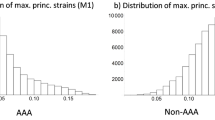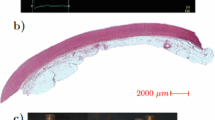Abstract
Aortic dissection is the most common catastrophe of the thoracic aorta, with a very high rate of mortality. Type A dissection is often associated with an ascending thoracic aortic aneurysm (ATAA). However, it is widely acknowledged that the risk of type A dissection cannot be reliably predicted simply by measuring the ATAA diameter and there is a pressing need for more reliable risk predictors. It was previously shown that there is a significant correlation between a rupture criterion based on the ultimate stretch of the ATAA and the local extensional stiffness of the aorta. Therefore, reconstructing regional variations of the extensional stiffness across the aorta appears highly important. In this paper, we present a novel noninvasive inverse method to identify the patient-specific local extensional stiffness of aortic walls based on preoperative gated CT scans. Using these scans, a structural mesh is defined across the aorta with a set of nodes attached to the same material points at different time steps throughout the cardiac cycle. For each node, time variations of the position are analyzed using Fourier series, permitting the reconstruction of the local strain distribution (fundamental term). Relating these strains to tensions with the extensional stiffness, and writing the local equilibrium satisfied by the tensions, the local extensional stiffness is finally derived at every position. The methodology is applied onto the ascending and descending aorta of three patients. Interestingly, the regional distribution of identified stiffness properties appears heterogeneous across the ATAA. Averagely, the identified stiffness is also compared with values obtained using other nonlocal methodologies. The results support the possible noninvasive prediction of stretch-based rupture criteria in clinical practice using local stiffness reconstruction.










Similar content being viewed by others
References
Antiga L, Steinman DA (2004) Robust and objective decomposition and mapping of bifurcating vessels. IEEE Trans Med Imaging 23(6):704–13
Avril S, Badel P, Duprey A (2010) Anisotropic and hyperelastic identification of in vitro human arteries from full-field optical measurements. J Biomech 43:2978–85
Baek S, Gleason RL, Rajagopal KR, Humphrey JD (2007) Theory of small on large: potential utility in computations of fluid-solid interactions in arteries. Comput Methods Appl Mech Eng 196:3070–78
Bersi MR, Belliniand C, Di Achille P, Humphrey JD, Genovese K, Avril S (2016) Novel methodology for characterizing regional variations in the material properties of murine aortas. J Biomech Eng 138:071005
Bickerstaff LK, Pairolero PC, Hollier LH, Melton LJ, Van Peenen HJ, Cherry KJ et al (1982) Thoracic aortic aneurysms: a population-based study. Surgery 92:1103–08
Chau KH, Elefteriades JA (2013) Natural history of thoracic aortic aneurysms: size matters and plus moving beyond size. Prog Cardiovasc Dis 56(1):74–80
Choudhury N, Olivier B, Leonie R, Dominique T, Raymond C, Jagdish B et al (2009) Local mechanical and structural properties of healthy and diseased human ascending aorta tissue. Cardiovasc Pathol 18:83–91
Coady MA, Rizzo JA, Hammond GL, Kopf GS, Elefteriades JA (1999) Surgical intervention criteria for thoracic aortic aneurysms: a study of growth rates and complications. Ann Thorac Surg 67(6):1922–6
Coady MA, Rizzo JA, Hammond GL, Mandapati D, Darr U, Kopf GS, Elefteriades JA (1997) What is the appropriate size criterion for resection of thoracic aortic aneurysms? J Thorac Cardiovasc Surg 113(3):476–91
Davis FM, Luo Y, Avril S, Duprey Ambroise A, Lu J (2016) Local mechanical properties of human ascending thoracic aneurysms. J Mech Behav Biomed Mater 61:235–49
Davis FM, Luo Y, Avril S, Duprey A, Lu J (2015) Pointwise characterization of the elastic properties of planar soft tissues: application to ascending thoracic aneurysms. Biomech Model Mechanobiol 14:967–78
Duprey A, Khanafer K, Schlicht M, Avril S, Williams D, Berguer R (2010) In vitro characterisation of physiological and maximum elastic modulus of ascending thoracic aortic aneurysms using uniaxial tensile testing. Eur J Vasc Endovasc Surg 39(6):700–7
Duprey A, Trabelsi O, Vola M, Favre JP, Avril S (2016) Biaxial rupture properties of ascending thoracic aortic aneurysms. Acta Biomater 42:273–85
McGloughlin T (ed) (2011) Biomechanics and mechanobiology of aneurysms. Springer, Heidelberg
Elefteriades JA, Farkas EA (2010) Thoracic aortic aneurysm clinically pertinent controversies and uncertainties. J Am Coll Cardiol 55(9):841–57
Ferrara A, Morganti S, Totaro P, Mazzola A, Auricchio F (2016) Human dilated ascending aorta: mechanical characterization via uniaxial tensile tests. J Mech Behav Biomed Mater 53:257–71
Fillinger MF, Marra SP, Raghavan ML, Kennedy FE (2003) Prediction of rupture risk in abdominal aortic aneurysm during observation: wall stress versus diameter. J Vasc Surg 37(4):724–32
Fung YC (1993) Biomechanics: mechanical properties of living tissues. Springer, Berlin
García-Herrera CM, Atienza JM, Rojo FJ, Claes E, Guinea GV, Celentano DJ, García-Montero C, Burgos RL (2008) Mechanical behaviour and rupture of normal and pathological human ascending aortic wall. Med Biol Eng Comput 50(6):559–66
Geest JP Vande, Di Martino ES, Bohra A, Makaroun MS, Vorp DA (1085) A biomechanics-based rupture potential index for abdominal aortic aneurysm risk assessment: demonstrative applicatio. Ann N Y Acad Sci 11–21:2006
Geest JP Vande, Sacks MS, Vorp DA (2004) Age dependency of the biaxial biomechanical behavior of human abdominal aorta. J Biomech Eng 126:815–22
Groenink M, de Roos A, Mulder BJ, Spaan JA, van der Wall EE (1998) Changes in aortic distensibility and pulse wave velocity assessed with magnetic resonance imaging following beta-blocker therapy in the marfan syndrome. Am J Cardiol 82:203–8
Haker S, Angenent S, Tannenbaum A, Kikinis R (2000) Nondistorting flatting maps and the 3-D visualization of colon CT images. IEEE Trans Med Imaging 19:665–670
Hibbitt, Karlsson & Sorensen (2011) Abaqus-Theory manual, 6.11-3 edn. Hibbitt, Karlsson & Sorensen, Providence
Holzapfel GA (2006) Determination of material models for arterial walls from uniaxial extension tests and histological structure. J Theor Biol 238:290–302
Holzapfel GA, Gasser TC, Ogden RW (2000) A new constitutive framework for arterial wall mechanics and a comparative study of material models. J Elast Phys Sci Solids 61(1):1–48
Holzapfel GA, Gasser TC, Ogden RW (2000) A new constitutive framework for arterial wall mechanics and a comparative study of material models. J Elast Phys Sci Solids 61(1–3):1–48
Humphrey JD (2008) Vascular adaptation and mechanical homeostasis at tissue, cellular, and sub-cellular levels. Cell Biochem Biophys 50:53–78
Iliopoulos DC, Deveja RP, Kritharis EP, Perrea D, Sionis GD, Toutouzas K, Stefanadis C, Sokolis DP (2008) Regional and directional variations in the mechanical properties of ascending thoracic aortic aneurysms. Med Eng Phys 31(1):1–9
Iliopoulos DC, Kritharis EP, Giagini AT, Sokolis DP, Papadodima SA (2009) Ascending thoracic aortic aneurysms are associated with compositional remodeling and vessel stiffening but not weakening in age-matched subjects. J Thorac Cardiovasc Surg 137(1):101–9
Johansson G, Markström U, Swedenborg J (1995) Ruptured thoracic aortic aneurysms: a study of incidence and mortality rates. J Vasc Surg 21(6):985–8
Joldes GR, Miller K, Wittek A, Doyle B (2016) A simple, effective and clinically applicable method to compute abdominal aortic aneurysm wall stress. J Mech Behav Biomed Mater 58:139–48
Lu J, Zhou X, Raghavan ML (2007) Inverse elastostatic stress analysis in pre-deformed biological structures: demonstration using abdominal aortic aneurysms. J Biomech 40:693–6
Malvindi PG, Pasta S, Raffa GM, Livesey S (2016) Computational fluid dynamics of the ascending aorta before the onset of type a aortic dissection. Eur J Cardio-Thorac Surg 51(3):597–99
Martin C, Sun W, Pham T, Elefteriades J (2013) Predictive biomechanical analysis of ascending aortic aneurysm rupture potential. Acta Biomater 9(12):9392–400
Martufi G, Gasser TC, Appoo JJ, Di Martino ES (2014) Mechano-biology in the thoracic aortic aneurysm: a review and case study. Biomech Model Mechanobiol 13:917–928
Mohan D, Melvin JW (1982) Failure properties of passive human aortic tissue. I—uniaxial tension tests. J Biomech 15:887–902
Mousavi SJ, Avril S (2017) Patient-specific stress analyses in the ascending thoracic aorta using a finite-element implementation of the constrained mixture theory. Biomech Model Mechanobiol 16(5):1765–77
Mousavi SJ, Farzaneh S, Avril S (2017) Computational predictions of damage propagation preceding dissection of ascending thoracic aortic aneurysms. Int J Numer Method Biomed Eng 34(4):e2944
Okamoto RJ, Wagenseil JE, DeLong WR, Peterson SJ, Kouchoukos NT, Sundt TM 3rd (2002) Mechanical properties of dilated human ascending aorta. Ann Biomed Eng 30:624–35
Prendergast PJ, Lally C, Daly S, Reid AJ, Lee TC, Quinn D et al (2003) Analysis of prolapse in cardiovascular stents: a constitutive equation for vascular tissue and finite-element modelling. J Biomech Eng 125:692–99
Ramanath VS, Oh JK, Sundt TM 3rd, Eagle KA (2009) Acute aortic syndromes and thoracic aortic aneurysm. Mayo Clin Proc 84(5):465–81
Sassani SG, Tsangaris S, Sokolis DP (2015) Layer- and region-specific material characterization of ascending thoracic aortic aneurysms by microstructure-based models. J Biomech 48(14):3757–65
Sokolis DP (2007) Passive mechanical properties and structure of the aorta: segmental analysis. Acta Physiol (Oxf) 190:277–289
Sokolis DP (2015) Effects of aneurysm on the directional, regional, and layer distribution of residual strains in ascending thoracic aorta. J Mech Behav Biomed Mater 46:229–43
Sokolis DP, Kritharis EP, Giagini AT, Lampropoulos KM, Papadodima SA, Iliopoulos DC (2012) Biomechanical response of ascending thoracic aortic aneurysms: association with structural remodelling. Comput Methods Biomech Biomed Eng 15(3):231–48
Trabelsi O, Davis FM, Rodriguez-Matas JF, Duprey A, Avril S (2015) Patient specific stress and rupture analysis of ascending thoracic aneurysms. J Biomech 48(10):1836–43
Trabelsi O, Gutierrez M, Farzaneh S, Duprey A, Avril S (2017) A non-invasive technique for ATAA rupture risk estimation. J Biomech. https://doi.org/10.1016/j.jbiomech.2017.11.012
van Disseldorp EM, Petterson NJ, Rutten MC, van de Vosse FN, van Sambeek MR, Lopata RG (2016) Patient specific wall stress analysis and mechanical characterization of abdominal aortic aneurysms using 4D ultrasound. Eur J Vasc Endovasc Surg 52:635-42
Vorp DA, Schiro BJ, Ehrlich MP, Juvonen TS, Ergin MA, Griffith BP (2003) Effect of aneurysm on the tensile strength and biomechanical behavior of the ascending thoracic aorta. Ann Thorac Surg 75:1210–14
Wittek A, Karatolios K, Bihari P, Schmitz-Rixen T, Moosdorf R, Vogt S, Blase C (2013) In vivo determination of elastic properties of the human aorta based on 4D ultrasound data. J Mech Behav Biomed Mater 27:167–183
Wittek A, Karatolios K, Fritzen CP, Bereiter-Hahn J, Schieffer B, Moosdorf R, Vogt S, Blase C (2016) Cyclic three-dimensional wall motion of the human ascending and abdominal aorta characterized by time-resolved three-dimensional ultrasound speckle tracking. Biomech Model Mechanobiol 15(5):1375–88
Acknowledgements
The authors are grateful to the European Research Council for Grant ERC-2014-CoG BIOLOCHANICS.
Author information
Authors and Affiliations
Corresponding author
Ethics declarations
Conflict of interest
The authors declare that they have no conflict of interest.
Additional information
Publisher's Note
Springer Nature remains neutral with regard to jurisdictional claims in published maps and institutional affiliations.
Electronic supplementary material
Below is the link to the electronic supplementary material.
Rights and permissions
About this article
Cite this article
Farzaneh, S., Trabelsi, O. & Avril, S. Inverse identification of local stiffness across ascending thoracic aortic aneurysms. Biomech Model Mechanobiol 18, 137–153 (2019). https://doi.org/10.1007/s10237-018-1073-0
Received:
Accepted:
Published:
Issue Date:
DOI: https://doi.org/10.1007/s10237-018-1073-0




